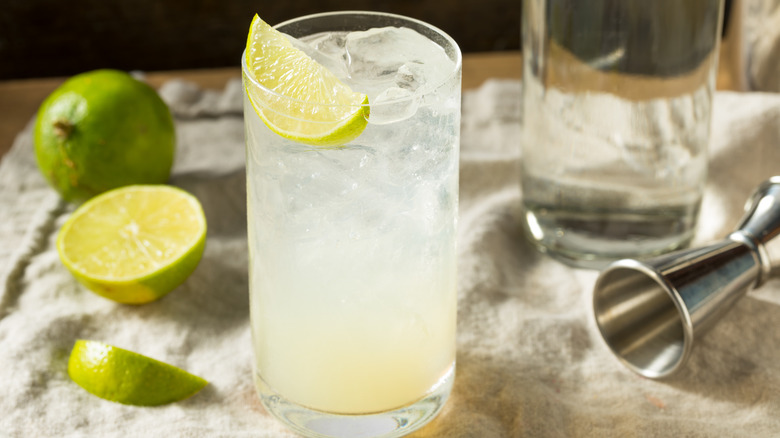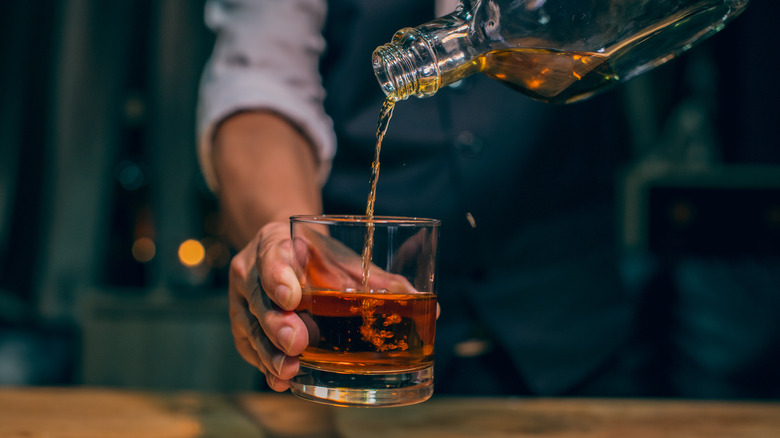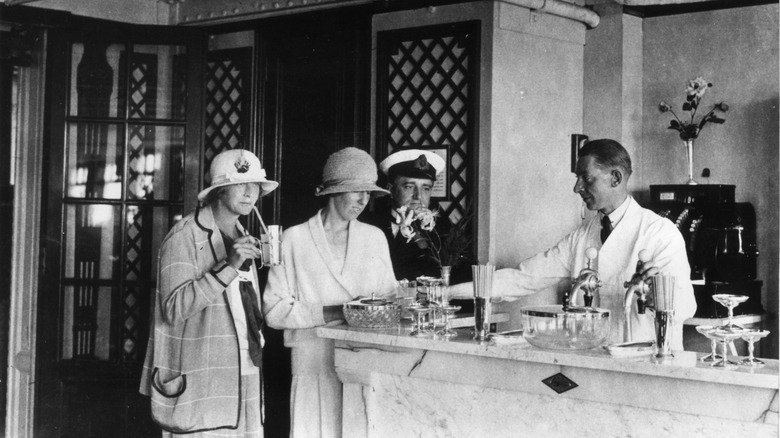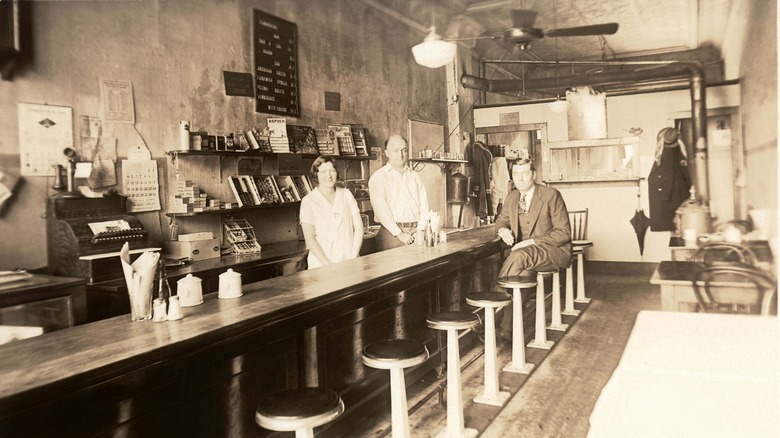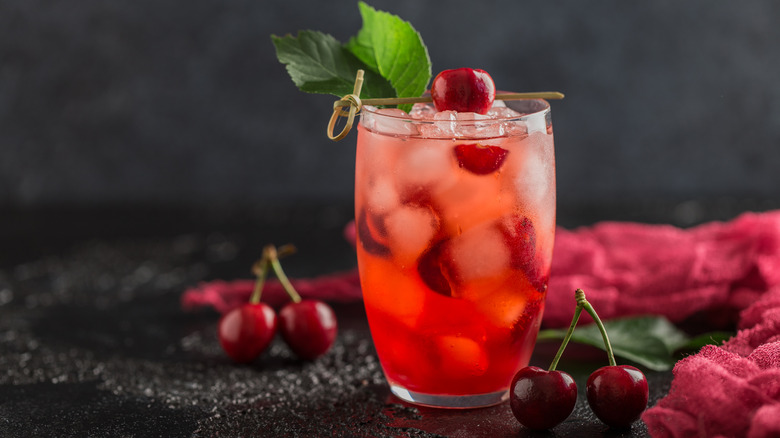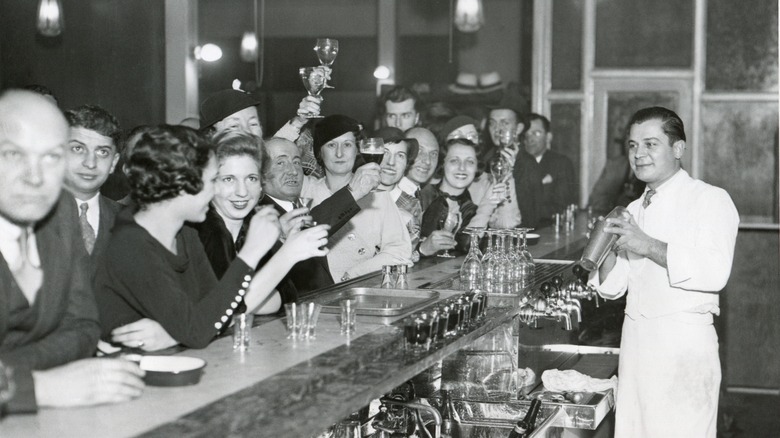How The Lime Rickey Mocktail Surged In Popularity During Prohibition
When you think of Prohibition, you probably imagine people drinking moonshine or partying at the glamorous underground speakeasies that tend to embody the popular zeitgeist of that time. However, you might be surprised to learn that Prohibition didn't just usher in a new era of secretive drinking. From January 17, 1920, when the 18th Amendment was ratified and Prohibition was enacted, to December 5, 1933, when Prohibition was repealed, a good amount of people did significantly lower their consumption of alcohol, according to the American Journal of Public Health.
As a result, many nonalcoholic beverages — what we might today call mocktails – experienced a rise in popularity, and quite a few of them have stuck around to this day. One of the most well-known virgin cocktails to emerge from the Prohibition era just might be the lime rickey. However, the drink wasn't a completely original invention. In fact, it is commonly considered to be a close cousin of the rickey, a popular alcoholic cocktail that was first mixed in Washington, D.C. in the late 1880s, according to Chilled Magazine.
The rickey was invented in the late 1880s
The rickey was the brainchild of bartender George Williamson, who was the proprietor of Shoomaker's, a dive bar near the Hill frequented by presidents, journalists, and a number of influential people in late-19th century D.C., according to Inside Hook. One such influential bar patron was Colonel Joe Rickey, a Democratic lobbyist who visited Shoomaker's almost daily around 10 a.m. for his morning drink.
He always took his "mornin's mornin'," as he called it, the same way each day. Rickey ordered "2 ounces of the bar's finest Kentucky whiskey in a goblet with a cube of ice, and topped with fizzy Apollinaris water," according to the Wall Street Journal. But while the base beverage might have come from the mind of Colonel Rickey himself, Williamson took the cocktail to the next level by coming up with the idea of adding a squeeze of fresh lime juice to the drink. Rickey loved it, and a boozy hit was born. Soon, other patrons began asking for a "Joe Rickey drink" at the bar. It took off, first in Washington D.C., and then the rest of the country. Soon, bar patrons across the United States were ordered their highballs the "Rickey" way, with liquor, ice, fresh lime juice, and carbonated water.
The soda fountain became a popular gathering place during Prohibition
However, the original recipe called for Joe Rickey's favorite liquor, which was whiskey. But not long after the rickey made its appearance on the bar scene, people began to prefer swapping out the dark liquor with cooler, lighter, more refreshing gin. Over time, the gin rickey became the more popular cocktail, even though "it used to eat [Rickey] up that everybody was making it with gin because Joe's lime rickey was made with whiskey," bartending legend Dale DeGroff, author of "The Craft of the Cocktail" explained to Inside Hook. And once the Prohibition era began, Rickey's recipe would undergo another major change.
Once the 18th Amendment was put into effect, some enterprising soda jerks decided to give the classic rickey cocktail another makeover, with a Prohibition twist. In the 1920s, many people were searching for something to replace their favorite boozy beverages and bar hangouts, so the soda fountain grew to fill that role. Not simply a central hangout for bored teenagers, many adults looking for a new public place to congregate after the bars were shut down turned to their local soda fountain, according to MinnPost. Taking on the role of "bartender" in this new era, soda jerks began experimenting with their own mocktails, crafting tasty, original nonalcoholic drinks to serve customers looking to fill the void left by the loss of their favorite boozy beverage.
Soda jerks began serving the nonalcoholic lime rickey
However, soda jerks soon realized they didn't exactly have to reinvent the wheel. In fact, many classic cocktails could be easily reworked by simply removing the alcohol and keeping the core recipes otherwise pretty much the same (per Wine History Project). And at the heart of these new, alcohol-free cocktails remained the ever-popular gin rickey riff.
Soda jerks soon realized they could deliver a successful cocktail by serving just the "rickey" part of the drink. They decided to keep the rickey recipe essentially the same, with ice, unsweetened soda water, tart, fresh lime juice, and a lime wedge garnish, but simply omit the booze entirely. Thus, the lime rickey was born. Because rickeys don't traditionally contain sugar, the lime rickey retained some of the strong, bitter kick of an alcoholic cocktail, making them one of the most popular substitutes of the Prohibition era. "The true lime rickey was the soda fountain drink most like an alcoholic drink, because if done right [it] is almost truly unpalatable. It was most frequently ordered by a teenage boy looking to impress his girlfriend," Thomas Reilly, a former soda fountain worker, explained, via Serious Eats.
Lime rickeys were popular as a nonalcoholic cocktail substitute
Officially, a traditional lime rickey contains nothing more than lime juice, ice, and unsweetened carbonated water sans sugar, according to A Couple Cooks. The drink surged to popularity during the Prohibition era as a soda fountain favorite because "it was one of the standards of trying to mocktail yourself into not drinking," Taylor Peck, a San Francisco-based boutique soda shop co-owner explained to Serious Eats. "Lime was able to give you a kick. It comes through with that sharp tartness, and has a deeper, more mature bitterness that a lemon is lacking. Having a lime rickey without bourbon is better than, say, spiked lemonade without liquor. It's more of an adult drink even in its soda form," Peck added.
However, soon other virgin rickey recipes began to take over the market. Soda fountains were known for making their own homemade syrups to sweeten up drinks, and the tart lime rickey was certainly not immune to the sweet syrup treatment. The cherry lime rickey, which was made with fresh cherry syrup, emerged as a popular alternate version of the original, adding a hint of sweetness to complement the tart lime. Other syrups, such as raspberry, grape, or even just simple sugar by itself, were also added to adjust the flavor of the lime rickey to appeal to more bitter-averse palates, according to LoveToKnow.
Lime rickeys fell out of fashion after Prohibition ended
The lime rickey remained a beloved mocktail for almost the entire duration of the soda fountain's peak cultural saturation. However, as the teetotalling lifestyle fell out of favor, so did the soda fountain's popularity (per ThoughtCo). By 1933, Prohibition had been repealed, and there was no longer as much of a need for soda fountains to replace the barroom as a local gathering place.
Lime rickeys were another casualty of the end of Prohibition in large part due to the fact that their appeal really only worked when they were freshly made and consumed onsite. The success of many other sodas and soft drinks, which received a popularity boost during the teetotalling 1920s, were seized upon by manufacturers, who bottled and sold the beverages for home consumption, according to Serious Eats. However, the fresh and fizzy lime rickey didn't bottle as well as soft drinks did, so once people stopped congregating at their local soda fountains, the drink fell out of fashion as well. Eventually, the lime rickey became more of a drink of a bygone era than a beloved beverage. However, if you ever find yourself craving a nonalcoholic drink with a bit of a kick, you might find that the appeal of this light, refreshing mocktail still holds up after all these years.
